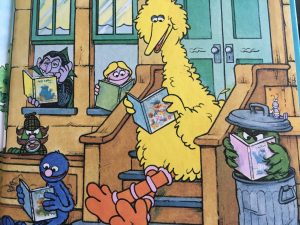 One of the joys of social media is how random posts pop up under your nose.
One of the joys of social media is how random posts pop up under your nose.
That’s how I ran across @HistoryMuppet on Twitter (sadly, no longer around on X). This was “a fan page run by Joshua Gillespie and dedicated to continuing the spirit and silliness of Jim Henson.”
Take a look at this clip of six grown adults clucking maniacally for 35 seconds, a clip from the late Muppet creator Jim Henson’s memorial in 1990. As @HistoryMuppet said, “My hope is that when I pass away, my friends will gladly sing as chickens during my memorial.”
The creators of Sesame Street knew that the Muppet chickens were always good for a laugh. Apparently, the show had a rule of thumb: “When in doubt, throw a chicken.”
But the show isn’t just about being funny or clever. The show has always aimed to effectively reach both children and their parents. A 2010 interview with the head writer, Joseph Mazzarino, explains:
“There’s no better way for the child to get the concepts we’re giving them than when they’re sitting down with their parents, watching.”
Some of the musical parodies are a natural. “Bruce Stringbean” sings Born To Add. “The Beetles” sing Letter B. Feist sings a version of her own 1,2,3,4, adding “monsters walking cross the floor.” You’ll find lots more on the Sesame Street YouTube channel, which now has 3,871 videos, 26.5 million subscribers and 26 billion views.
Sesame Street is also among the Writers Guild of America’s 101 best-written TV series (at #56; The Sopranos is #1). As the Writers Guild puts it, “the show’s continual inventiveness and impact as an educational tool forged via the runaway popularity of the Muppets changed the landscape of children’s television.”
So what can writers take away from Sesame Street? Try these seven tips:
1. Know your audience. What’s important to your readers/viewers? What do they already know? How short is their attention span (hint: VERY short) and how quickly can you make your point?
2. Be clear about what you need to get across and focus on that. Too many points water down your message, distract and even bore your reader/viewer. What one thing do you want people to remember?
3. Tell a story to make it memorable. We’re more likely to remember a fact, a number or a summary when it has been wrapped in a story.
4. Keep it easy to read and understand. You may not have children reading your work, but you will have people with little time to read. Help them out by getting to the point. No one will complain that you’ve made it too easy to understand.
5. Keep it short. Who has time or patience for long introductions, long paragraphs, long sentences, long words?
6. Think about references to pop culture as a way to capture attention or make a connection. You could echo the words of a song, reflect current television shows or parody an ad (think of Grover as the Old Spice guy in Smell Like a Monster – a classic!).
7. Don’t be afraid to be silly or play with words. You may not be able to follow the Sesame Street chicken rule, but guaranteed you can lighten up.
What have YOU learned from Sesame Street or other shows you love?
Related reading:
Use plain language to be clear
Choose your words wisely to be understood (about readable writing)
Updated April 24, 2025.
Image: Photo of one of my own Sesame Street books, Wait For Me! by Molly Cross, with illustrations by Joe Mathieu. This is an update of an article that originally appeared in my newsletter, Wordnerdery. Not a subscriber? Sign up now for my monthly take on writing, words, newsletters and more. In keeping with anti-spam laws, you can easily unsubscribe at any time.
